2. 中国烟草总公司云南省公司 昆明 650011;
3. 云南省烟草农业科学研究院 昆明 650021
2. China Tobacco Company Yunnan Branch, Kunming 650011, China;
3. Yunnan Academy of Tobacco Agricultural Sciences, Kunming 650021, China
山地烟田是我国烟叶生产的主体, 2018年我国山地烟移栽面积6.0x105 hm2, 占全国烤烟(Nicotiana tabacum L.)移栽面积的66.5%。旋耕、浅翻耕是当前我国山地烟区的主要土壤耕作模式, 长期单一的旋耕、浅翻耕耕作模式导致山地烟田耕层结构“浅、实、少”问题突出, 即耕层浅、土壤紧实、耕层有效土壤量少[1-2]。耕层结构质量直接影响烤烟根系的空间构型, 对烤烟生长发育和烟叶产量质量影响重大[3]。合理的土壤耕作, 对降低土壤紧实度、扩充土壤蓄水库容、促进烤烟早生快发、协调烟株地上部和地下部生长、提升烤烟产量产值有重要影响[4-5]。因此, 探究不同耕作方式对山地烟田土壤物理性状、烟株生长发育及烤烟根系空间分布的影响, 对改进山地烟区烟田耕作模式具有重要现实意义。深耕、深松耕作措施可有效打破农田犁底层、扩增土体耕层厚度、增加有效土壤量。深松耕作是随着保护性耕作发展起来的一种代替传统翻耕的土壤耕作措施, 通过深松铲或凿形犁等松土部件疏松土壤而不翻转土层。前人研究表明, 深松耕作可降低耕层土壤容重, 增加孔隙度, 改善土壤水分传导性能, 促进根系向深层土壤定向生长, 提高根系对深层土壤水分养分的吸收利用, 促进作物地上部生长发育, 提高群体根表面积指数与群体叶面积指数, 进而提高作物产量及质量[6-8]。深松增产增效机理在棉花(Gossypium spp. L.)[9]、玉米(Zea mays L.)[10]、小麦(Triticum aestivum L.)[11]等作物上的研究较多, 对山地烟田烤烟生产的影响及作用机理, 特别是对烤烟根系空间分布特征的影响尚缺乏深入研究。本文依托田间试验, 探讨不同耕作方式对山地烟田土壤物理性状、烤烟生长发育及烟叶产值产量的影响, 通过小立方原位取样定量研究不同耕作方式下烤烟根系空间分布特征, 明确深耕、深松对烟叶提质增效的作用机理, 以期为山地烟区烟田耕作模式的改进提供有益参考。
1 材料与方法 1.1 试验区概况试验于2018年3—9月在云南省玉溪市红塔区高仓街道(24°30′N, 103°32′E)进行。该地区为云南滇中烟区典型山地烟种植区域, 耕地资源主要以缓坡地或台地为主。年均降雨量为779.5~989.7 mm, 年平均气温15.6~23.8 ℃, 年无霜期244~365 d, 年平均日照2 115~2 285 h。试验地海拔高度为1 760 m, 土壤类型为红壤土, 灌溉方式为穴灌, 前茬作物为小麦, 土地相对平坦, 排水良好, 土壤肥力偏低, 翻耕前0~20 cm土层土壤基础性状为: pH 6.72, 有机质17.8 g·kg-1, 水解氮79.1 mg·kg-1, 有效磷37.4 mg·kg-1, 速效钾204 mg·kg-1, 全氮0.75 g·kg-1, 全磷1.28 g·kg-1, 全钾7.7 g·kg-1, 氯离子3.20 mg·kg-1。
1.2 试验设计和田间管理供试材料为当地常规栽培烤烟品种‘K326’。采用单因素随机区组试验, 设置4种土壤耕作方式处理:旋耕20 cm(RT20, 对照), 利用旋耕机刀片切削、打碎土块, 疏松混拌耕层土壤, 旋耕深度20 cm; 深耕30 cm(DT30), 通过904东方红拖拉机三点悬挂铧式犁深翻耕地, 深耕深度30 cm; 深松30 cm(ST30)、深松40 cm(ST40), 通过904东方红拖拉机三点悬挂凿式深松铲疏松土壤而不翻转土层, 利用拖拉机液压控制深松机高度, 控制深松深度分别为30 cm、40 cm。深耕、深松完成后, 将烟田细耙整地, 至土垡细碎。每个处理设3次重复, 共12个小区, 各小区面积为108 m2 (7.2 m × 15 m)。烤烟株行距分别为0.6 m和1.2 m。2018年3月24日按试验设置开展耕整地, 4月23日起垄理墒打塘, 垄高25 cm。4月26日膜下小苗移栽, 移栽前施用腐熟农家肥7 500 kg·hm-2和烟草复合肥(N:P2O5:K2O=12:6:24)200 kg·hm-2, 移栽后10 d兑水浇施烟草复合肥225 kg·hm-2, 移栽30 d后开展揭膜、追肥、培土等烟田中耕管理, 追肥为塘内环施钾肥(农用硫酸钾, K2O≥50%)275 kg·hm-2。病虫害防治及其他田间管理措施参照当地优质烟叶生产管理办法执行。
1.3 测定项目与方法 1.3.1 烤烟产量产值烟叶成熟后, 对各小区烟叶进行单采单烤, 根据烤烟42级国标(GB 2635—92)对烤后烟叶进行专业化分级, 并统计烤后烟叶产量, 确定烤烟产值、均价和上等烟比例。
1.3.2 烤烟干物质烤烟团棵期、旺长期和现蕾期, 通过挖掘法选取各处理3棵代表性烟株, 清水净洗后放入烘箱, 105 ℃杀青30 min, 60 ℃烘干至恒重, 称量不同处理烤烟地上部和地下部生物量干重。
1.3.3 土壤物理性状烤烟旺长期, 在每个小区连续两株代表性烤烟之间的垄面上布置1个取样点, 环刀法测定0~10 cm、10~20 cm、20~30 cm、30~40 cm和40~50 cm土壤容重、总孔隙度、毛管孔隙度、非毛管孔隙度[12], 每个处理重复测定3次。
1.3.4 土壤含水量烤烟团棵期、现蕾期, 利用土钻在每个小区连续两株代表性烤烟之间的垄面上布置1个取样点, 取0~10 cm、10~20 cm、20~30 cm、30~40 cm和40~50 cm土样, 105 ℃烘干测定土壤质量含水量, 每个处理重复测定3次。
1.3.5 烤烟根系空间分布特征烤烟现蕾期, 利用小立方原位根土取样器[13], 通过“3D monolith”[14]分层空间取样方法, 每10 cm为一土层, 取到50 cm, 每层以烤烟植株为中心取9个土块, 以体积10 cm×10 cm×10 cm的土块为取样单位(图 1)。每个小区选定1棵代表性烟株进行根系小立方取样。
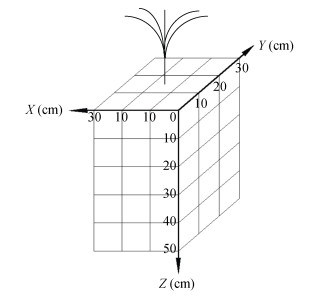
|
图 1 田间烤烟根系土壤取样坐标 Fig. 1 Sampling coordinate of cotton root in the filed |
| $ 根深指数\left( {{\rm{cm}}} \right){\rm{ = }}\sum {\left[ {各层次平均深度\left( {{\rm{cm}}} \right) \times 该层次根系干重占总根重的百分比} \right]} $ | (1) |
采用SPSS 17.0 (SPSS, Inc.)统计分析数据和检验显著性(显著水平为P < 0.05), 采用Microsoft Excel 2007和Surfer 8.0 (Golden Software, Inc.)制图。
2 结果与分析 2.1 不同耕作方式对烤烟产量、产值的影响由表 1可知, 不同土壤耕作方式下烤烟产量产值有显著性差异。与对照旋耕(RT20)相比, 深耕(DT30)、深松(ST30、ST40)显著提高烤烟的产量、产值, 其中DT30、ST30、ST40产量分别提高12.2%、12.3%和16.0%, 产值分别提高10.5%、13.8%和21.8%。
| 表 1 不同耕作处理对烤烟产量及产值的影响 Table 1 Effects of different tillage methods on tobacco leaf yield and output |
从烤烟地上部干物质看, 团棵期DT30、ST30、ST40处理与对照RT20差异显著, 比对照分别高44.1%、38.2%和94.1%;至现蕾期, DT30处理与对照无明显差异, ST30、ST40处理分别比对照高24.0%和47.5%, 差异变小(图 2)。从烤烟地下部干物质看, 团棵期至旺长期, DT30、ST40处理与对照烤烟生长发育差异逐步缩小; 至现蕾期, DT30、ST30处理与对照差异不显著, ST40处理与对照差异显著。说明深耕、深松措施可促进移栽后烤烟早生快发, 且深松措施在烤烟生长中后期仍持续发挥促进作用。
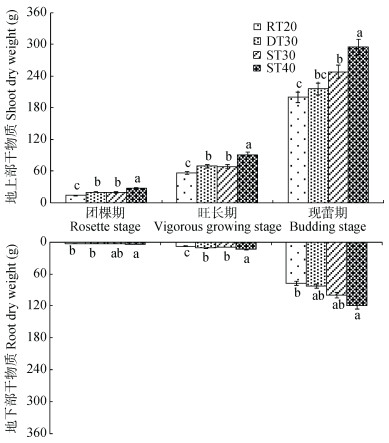
|
图 2 不同耕作方式对不同生育期烤烟干物质的影响 Fig. 2 Effects of different tillage methods on dry matter of flue-cured tobacco at different growth stages RT20:旋耕20 cm, 对照; DT30:深耕30 cm; ST30:深松30 cm; ST40:深松40 cm。同一生育期不同字母表示处理间差异显著。RT20: 20 cm rotary tillage; DT30: 30 cm deep tillage; ST30: 30 cm subsoiling tillage; ST40: 40 cm subsoiling tillage. Different lowercase letters in the same growth stage mean significant differences at 0.05 level. |
由图 3可知, 深耕、深松处理对烟田表层0~20 cm和深层40~50 cm土壤物理性状无明显影响, 但对亚表层20~40 cm的土壤物理性状有良好的改良效果。土壤亚表层20~40 cm, DT30、ST30和ST40处理土壤容重分别为1.28 g·cm-3、1.29 g·cm-3和1.26 g·cm-3, 比对照RT20处理分别低5.7%、5.0%和7.4%; DT30、ST30和ST40土壤总孔隙度和毛管孔隙度均显著高于对照RT20, 其中总孔隙度分别比对照高6.2%、5.2%和12.7%, 毛管孔隙度分别比对照高11.3%、13.1%和21.6%。
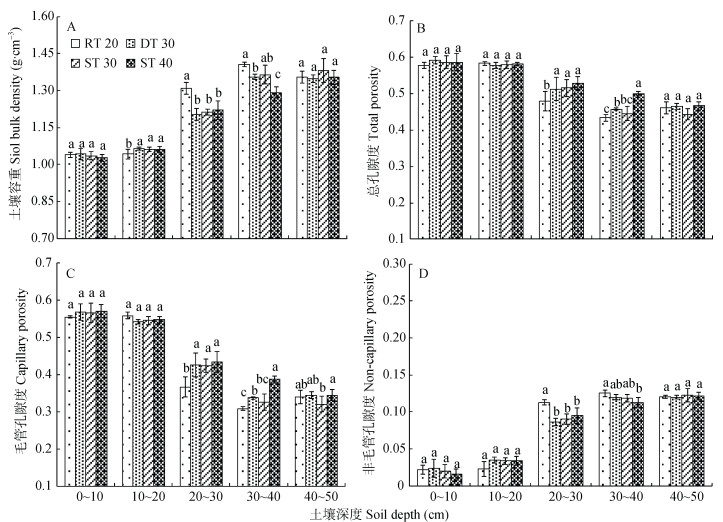
|
图 3 不同耕作方式对植烟土壤容重(A)、总孔隙度(B)、毛管孔隙度(C)和非毛管孔隙度(D)的影响 Fig. 3 Effects of different tillage methods on soil bulk density (A), total porosity (B), capillary porosity (C) and non-capillary porosity (D) in tobacco field RT20:旋耕20 cm, 对照; DT30:深耕30 cm; ST30:深松30 cm; ST40:深松40 cm。同一土层不同字母表示各处理在0.05水平上差异显著。RT20: 20 cm rotary tillage; DT30: 30 cm deep tillage; ST30: 30 cm subsoiling tillage; ST40: 40 cm subsoiling tillage. Different lowercase letters in the same soil layer mean significant differences at 0.05 level among different treatments. |
不同耕作处理对山地烟田土壤垂直剖面的水分分布有较大影响(图 4)。烤烟团棵期, 随着土层深度的增加, 土壤含水量先显著增加后趋于平稳, 且处理间的差距先变大后变小; 表层0~20 cm, 各处理间土壤含水量无明显差异; 亚表层20~40 cm, DT30、ST30和ST40处理土壤含水量显著高于对照, 比对照分别高4.9%、2.3%和5.7%。烤烟现蕾期, 随着土层深度的增加, 土壤含水量呈下降趋势, 且处理间的差距先变小后变大; 0~20 cm土层, 各处理与对照相比下降趋势较小; DT30、ST30和ST40处理显著提高20~40 cm土层的土壤含水量, 且分别比对照RT20高4.5%、3.8%和5.6%。说明深耕、深松措施促进了水分的入渗, 可显著提高土壤亚表层20~40 cm土壤含水量。

|
图 4 不同耕作方式对烤烟团棵期(A)和现蕾期(B)土壤水分的影响 Fig. 4 Effects of different tillage methods on soil moisture contents in tobacco field at rosette stage (A) and budding stage (B) RT20:旋耕20 cm, 对照; DT30:深耕30 cm; ST30:深松30 cm; ST40:深松40 cm。RT20: 20 cm rotary tillage; DT30: 30 cm deep tillage; ST30: 30 cm subsoiling tillage; ST40: 40 cm subsoiling tillage. |
不同耕作方式对烤烟根系空间分布特征的差异见图 5。图中立方体表面的每一点的高低代表了同一土层中不同位置根系鲜重的大小。图 5表明, 根系鲜重在0~20 cm土层呈现单峰值, 而在20~50 cm土层, 根系鲜重呈现多峰值。0~50 cm土层, DT30、ST30和ST40处理与对照RT20相比差异显著, 根系鲜重分别比对照高15.4%、18.1%和23.8%, 表明深耕、深松措施能显著增加烤烟地下部根系绝对生物量。不同耕作方式对烤烟根系鲜重的影响, 在20~50 cm表现出较大的差异, 其中DT30处理20~ 30 cm、30~40 cm和40~50 cm烤烟根系鲜重分别比对照高162.2%、56.5%、13.6%, ST30处理分别比对照高176.3%、137.5%和112.2%, ST40处理分别比对照高469.0%、292.9%和314.4%。
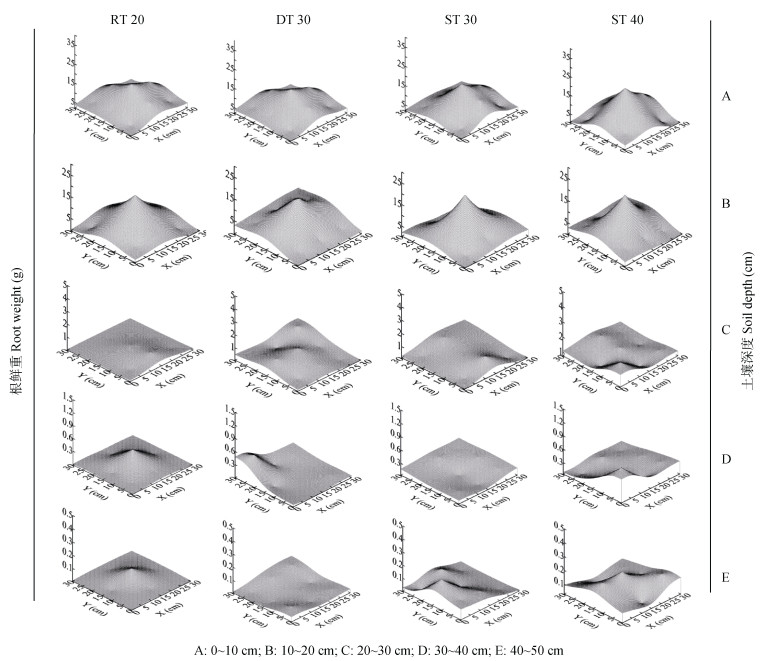
|
图 5 不同耕作方式下不同深度烤烟根系鲜重的空间分布 Fig. 5 Effects of different tillage methods on root spatial distribution of flue-cured tobacco in the soil depths of 0-10 cm (A), 10-20 cm (B), 20-30 cm (C), 30-40 cm (D), and 40-50 cm (E) (A: 0~10 cm; B: 10~20 cm; C: 20~30 cm; D: 30~40 cm; E: 40~50 cm)RT20:旋耕20 cm, 对照; DT30:深耕30 cm; ST30:深松30 cm; ST40:深松40 cm。RT20: 20 cm rotary tillage; DT30: 30 cm deep tillage; ST30: 30 cm subsoiling tillage; ST40: 40 cm subsoiling tillage. |
不同耕作方式下烤烟根系在土壤垂直剖面的分布特征及其差异见图 6。在0~50 cm土层, 烤烟根系鲜重随土层的加深先增加后减少, 超过89.9%的根系分布于0~20 cm土层。RT20、DT30、ST30和ST40处理土壤亚表层20~40 cm根系鲜重占0~50 cm垂直剖面总鲜重的比值分别为2.2%、4.5%、4.9%和9.4%。RT20、DT30、ST30和ST40处理烤烟根深指数分别为9.6 cm、10.1 cm、10.4 cm和10.9 cm。与对照RT20相比, DT30、ST30和ST40处理的根深指数分别提高5.32%、8.26%和16.20%。与旋耕相比, 深耕、深松耕作处理烤烟根系等质量分布线既宽又深, 且包含面积更大。说明深耕、深松措施促进了烤烟根系向深层土壤伸展, 增加烤烟根系在下层土壤的比例, 可缓解上层土壤根系的拥挤度。
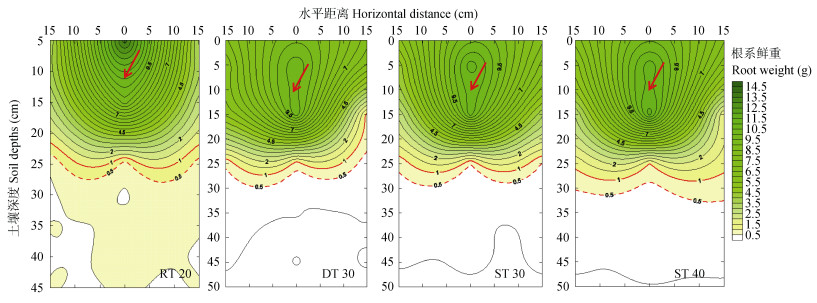
|
图 6 不同耕作方式下烤烟根系鲜重在土壤垂直剖面的分布 Fig. 6 Effect of different tillage methods on root vertical distribution of flue-cured tobacco in the soil RT20:旋耕20 cm, 对照; DT30:深耕30 cm; ST30:深松30 cm; ST40:深松40 cm。RT20: 20 cm rotary tillage; DT30: 30 cm deep tillage; ST30: 30 cm subsoiling tillage; ST40: 40 cm subsoiling tillage. |
云南、贵州、四川是我国烟叶主产区, 2018年西南三省烤烟移栽面积达5.83x105 hm2, 占全国总移栽面积的64.9%。丘陵山区、半山区是西南地区烟叶生产主战场, 山地烟区农田地块小、地块不平整、地块分布分散等问题较为突出。同时, 在我国城镇化快速推进和农村劳动力加快转移的背景下, 山地烟区农民对小型微耕机耕整地的依赖度越来越高, 山地烟田耕层浅薄化、土壤紧实化、犁底层上移等一系列土壤健康问题逐渐凸显。土壤耕作是以不同的外部机械力形式作用于土壤, 并从本质上改变土壤的物理性状, 调节土壤中水、肥、气、热等因子, 达到作物高产稳产优质的目的[12, 15-16]。本研究表明, 深耕、深松可有效改善土壤物理特征, 显著降低0~50 cm土壤容重, 提高总孔隙度及毛管孔隙度。黄健等[17]研究表明, 深松耕作处理较传统耕作方式能够显著降低土壤容重, 增加土壤通透性, 提高土壤的总孔隙度, 与本研究基本一致。烤烟生长前后期, 深耕、深松显著增加了土壤亚表层20~40 cm含水量。说明深耕、深松措施有效打破了山地烟田常年旋耕、浅翻耕形成的犁底层, 显著改善土壤总孔隙度及毛管孔隙度, 增加土壤透水能力和入渗深度, 降低地表径流与蒸发, 可为山地烤烟不同需水期提供充足水分[6, 18-20]。
3.2 不同耕作方式对烤烟根系空间分布的影响根系是作物吸收水分和养分的主要营养器官, 根系良好发育是保证作物高产高效的必要条件[21]。在作物高产栽培方面, 提高根系向深层土壤的纵向分布, 利于深层土壤中水分和养分的吸收; 深层土壤具有相对稳定的根系环境, 更利于根系活力的延长与延缓后期根系的衰老, 保持根系对地上部营养和水分供给, 有利于提高作物产量[22]。本研究表明, 山地烟田0~10 cm、10~20 cm土层烤烟根系鲜重呈单峰分布特征, 且随着与烟株中心位置距离的增加, 根系鲜重呈指数型降低趋势; 在20~50 cm土层, 根系鲜重呈多峰值分布。
在山地烟田土壤水平剖面20~40 cm土层, 深耕、深松措施能大幅度增加烤烟根系鲜重。这可能与深耕、深松措施打破山地烟田土壤犁底层, 改善土壤容重、总孔隙度、毛管孔隙度及土壤含水量有关。王娜等[2]、童文杰等[23]研究同样证明了深耕措施可有效地促进烟株根系的生长发育, 增加一级侧根和不定根的根数, 扩展根系的分布范围, 显著增加烤烟根系绝对量, 促进根系向深层土壤生长。
山地烟田土壤0~50 cm垂直剖面上, 烤烟根系鲜重逐步减少, 超过89.9%的根系分布于0~20 cm土层。与对照RT20相比, DT30、ST30和ST40处理的等质量分布线既宽又深, 且包含面积大, 说明深耕、深松措施促进了烤烟根系向深层土壤伸展, 增加烤烟根系在下层土壤的比例, 形成“纵向延伸”的根系构型, 进而缓解上层土壤根系的拥挤度, 促进烤烟根系对山地烟田土壤水分、养分的利用[24-25]。
3.3 不同耕作方式对山地烟田烤烟产值产量的影响适宜的耕作方式能够改善土壤的理化性质、改善作物生长微环境, 增强土壤通透性, 改善根系的生长、分布和功能, 增强作物的光合作用, 提高其对水分的充分利用, 最终达到增产增收的目的[26-27]。本研究表明, 深耕、深松处理可促进移栽后烤烟早生快发, 且深松措施在烤烟生长中后期仍持续发挥促进作用。经济性状结果显示, 深耕、深松措施提高了烤烟的产量、产值、上等烟比例和均价。这与前人研究结果较为一致, 采用深耕有助于提高烟叶产量和产值及上等烟率, 使烟地有最大的产出[2]。深耕和深松处理有效地改善了土壤环境, 促进烤烟根系的下扎, 提高烤烟根系对土壤养分的吸收, 进而作用于地上部形态的建成, 最终增加烤烟干物质积累[28]。这说明, 可能是土壤深耕、深松措施改善了山地烟田土壤环境, 优化烤烟根系空间分布, 有利于提高烟叶产量与质量, 使烤烟获得良好的经济效益[29-30]。本研究结果表明, 深耕30 cm和深松30 cm已满足山地烟田土壤的耕作要求, 深松40 cm虽然取得最大的产量、产值, 但深松40 cm需使用更大油耗的拖拉机, 综合考虑, 本试验条件下深耕、深松30 cm最适宜。
云南省的烟草种植区大多位于海拔1 500 m以上的地区, 地块小、田埂高, 地貌以丘陵山区为主。虽然现在由大、中型拖拉机悬挂牵引的深耕机或深松机能够达到打破犁底层的要求, 但是因其体积和重量大, 无法适应山地烟田深耕的工作要求。根据烟区烟田地形地貌、土壤特点和烟草种植等实际需要, 研发耕深可达30 cm以上的烟田小型深耕、深松机是亟待解决的问题。
4 结论与山地烟田传统耕作方式旋耕相比, 深松、深耕处理改善山地烟田土壤容重、孔隙度、土壤水分等土壤物理性状, 优化植烟土壤环境, 促进烤烟根系生长发育, 优化根系空间分布构型, 对增加烤烟干物质、提高烟叶产量产值有较好的现实生产意义。因此, 深耕、深松措施是适宜山地烟区烟叶生产的耕作方法, 深松、深耕在生产上各有优劣, 在实现土壤-作物综合生产力的提升目标时, 应因地制宜选用适宜的耕作良法、氮肥运筹及有机物还田等技术的综合运用。
| [1] |
汤文光, 肖小平, 张海林, 等. 轮耕对双季稻田耕层土壤养分库容及Cd含量的影响[J]. 作物学报, 2018, 44(1): 105-114. TANG W G, XIAO X P, ZHANG H L, et al. Effects of rotational tillage on nutrient storage capacity and Cd content in tilth soil of double-cropping rice region[J]. Acta Agronomica Sinica, 2018, 44(1): 105-114. |
| [2] |
王娜, 兰建强, 王定伟, 等. 不同耕作深度对烤烟生长及产、质量的影响[J]. 西南农业学报, 2014, 27(4): 1737-1740. WANG N, LAN J Q, WANG D W, et al. Effect of different plowing depths on growth-development, yield and quality of flue-cured tobacco[J]. Southwest China Journal of Agricultural Sciences, 2014, 27(4): 1737-1740. DOI:10.3969/j.issn.1001-4829.2014.04.078 |
| [3] |
徐天养, 赵正雄, 李忠环, 等. 耕作深度对烤烟生长、养分吸收及产量、质量的影响[J]. 作物学报, 2009, 35(7): 1364-1368. XU T Y, ZHAO Z X, LI Z H, et al. Effect of tilling depth on growth, nutrient uptake, yield and quality of flue-cured tobacco plant[J]. Acta Agronomica Sinica, 2009, 35(7): 1364-1368. |
| [4] |
许迪, SCHMID R, MERMOUD A. 夏玉米耕作方式对耕层土壤特性时间变异性的影响[J]. 水土保持学报, 2000, 14(1): 64-70. XU D, SCHMID R, MERMOUD A. Effects of tillage practices on temporal variations of soil surface properties[J]. Journal of Soil and Water Conservation, 2000, 14(1): 64-70. DOI:10.3321/j.issn:1009-2242.2000.01.013 |
| [5] |
VERHULST N, GOVAERTS B, VERACHTERT E, et al. Conservation agriculture, improving soil quality for sustainable production systems?[M]//LAL R, STEWART B A. Advances in Soil Science: Food Security and Soil Quality. Boca Raton, FL: CRC Press, 2010
|
| [6] |
VERHULST N, NELISSEN V, JESPERS N, et al. Soil water content, maize yield and its stability as affected by tillage and crop residue management in rainfed semi-arid highlands[J]. Plant and Soil, 2011, 344(1/2): 73-85. |
| [7] |
张瑞富, 杨恒山, 高聚林, 等. 深松对春玉米根系形态特征和生理特性的影响[J]. 农业工程学报, 2015, 31(5): 78-84. ZHANG R F, YANG H S, GAO J L, et al. Effect of subsoiling on root morphological and physiological characteristics of spring maize[J]. Transactions of the Chinese Society of Agricultural Engineering, 2015, 31(5): 78-84. DOI:10.3969/j.issn.1002-6819.2015.05.012 |
| [8] |
刘浩, 孙景生, 张寄阳, 等. 喷灌条件下耕作方式和亏缺灌溉对麦后移栽棉产量和水分利用的影响[J]. 应用生态学报, 2012, 23(2): 389-394. LIU H, SUN J S, ZHANG J Y, et al. Effects of tillage mode and deficit irrigation on the yield and water use of transplanted cotton following wheat harvest under sprinkler irrigation[J]. Chinese Journal of Applied Ecology, 2012, 23(2): 389-394. |
| [9] |
张建军, 王勇, 樊廷录, 等. 耕作方式与施肥对陇东旱塬冬小麦-春玉米轮作农田土壤理化性质及产量的影响[J]. 应用生态学报, 2013, 24(4): 1001-1008. ZHANG J J, WANG Y, FAN T L, et al. Effects of different tillage and fertilization modes on the soil physical and chemical properties and crop yield under winter wheat/spring corn rotation on dryland of east Gansu, Northwest China[J]. Chinese Journal of Applied Ecology, 2013, 24(4): 1001-1008. |
| [10] |
郑成岩, 崔世明, 王东, 等. 土壤耕作方式对小麦干物质生产和水分利用效率的影响[J]. 作物学报, 2011, 37(8): 1432-1440. ZHENG C Y, CUI S M, WANG D, et al. Effects of soil tillage practice on dry matter production and water use efficiency in wheat[J]. Acta Agronomica Sinica, 2011, 37(8): 1432-1440. |
| [11] |
鲍士旦. 土壤农化分析[M]. 第3版. 北京: 中国农业出版社, 2000. BAO S D. Soil Agro-Chemistrical Analysis[M]. 3rd ed. Beijing: China Agriculture Press, 2000. |
| [12] |
赵明. 作物产量性能与高产技术[M]. 北京: 中国农业出版社, 2013: 304-308. ZHAO M. The Crop Yield Performance and High Yield Technology[M]. Beijing: China Agriculture Press, 2013: 304-308. |
| [13] |
BÖHM W. Methods of Studying Root Systems[M]. Berlin, Heidelberg: Springer-Verlag, 1979.
|
| [14] |
孙利军, 张仁陟, 黄高宝. 保护性耕作对黄土高原旱地地表土壤理化性状的影响[J]. 干旱地区农业研究, 2007, 25(6): 207-211. SUN L J, ZHANG R Z, HUANG G B. Effects of the conservation tillage on the physicochemical characteristics of soil surface in the semi-arid areas of the Loess plateau[J]. Agricultural Research in the Arid Areas, 2007, 25(6): 207-211. |
| [15] |
DAO T H. Tillage and winter wheat residue management effects on water infiltration and storage[J]. Soil Science Society of America Journal, 1993, 57(6): 1586-1595. DOI:10.2136/sssaj1993.03615995005700060032x |
| [16] |
傅积平. 机械耕作条件下的土壤改良[M]. 北京: 中国农业出版社, 1978. FU J P. Soil Improvement under Mechanical Tillage[M]. Beijing: China Agriculture Press, 1978. |
| [17] |
黄健, 王爱文, 张艳茹, 等. 玉米宽窄行轮换种植、条带深松、留高茬新耕作制对土壤性状的影响[J]. 土壤通报, 2002, 33(3): 168-171. HUANG J, WANG A W, ZHANG Y R, et al. Effects of new cropping system on soil properties of wide and narrow spacing maize rotation planting, striply deep loosening and leaving high stubble on the ground[J]. Chinese Journal of Soil Science, 2002, 33(3): 168-171. DOI:10.3321/j.issn:0564-3945.2002.03.003 |
| [18] |
ALAMOUTI M Y, NAVABZADEH M. Investigation of plowing depth effect on some soil physical properties[J]. Pakistan Journal of Biological Sciences, 2007, 10(24): 4510-4514. DOI:10.3923/pjbs.2007.4510.4514 |
| [19] |
罗俊, 林兆里, 阙友雄, 等. 耕作深度对蔗地土壤物理性状及甘蔗产量的影响[J]. 应用生态学报, 2019, 30(2): 405-412. LUO J, LIN Z L, QUE Y X, et al. Effect of subsoiling depths on soil physical characters and sugarcane yield[J]. Chinese Journal of Applied Ecology, 2019, 30(2): 405-412. |
| [20] |
王浩, 王淑兰, 徐宗贵, 等. 耕作与施肥对旱地玉米田土壤耗水量和水分利用效率的影响[J]. 中国生态农业学报, 2017, 25(6): 856-864. WANG H, WANG S L, XU Z G, et al. Effect of tillage and fertilization on water use efficiency of maize in dryland conditions[J]. Chinese Journal of Eco-Agriculture, 2017, 25(6): 856-864. |
| [21] |
曹秀, 夏仁学, 杨环宇, 等. 沙培条件下磷、钾、钙亏缺对枳(Poncirus trifoliata)幼苗根系形态及营养吸收的影响[J]. 植物营养与肥料学报, 2014, 20(4): 981-988. CAO X, XIA R X, YANG H Y. Effects of P, K and Ca deficiency on the root morphology and nutrient absorption of Poncirus trifoliata seedlings[J]. Journal of Plant Nutrition and Fertilizers, 2014, 20(4): 981-988. |
| [22] |
王空军, 郑洪建, 刘开昌, 等. 我国玉米品种更替过程中根系时空分布特性的演变[J]. 植物生态学报, 2001, 25(4): 472-475. WANG K J, ZHENG H J, LIU K C, et al. Evolution of maize root distribution in space-time during maize varieties replacing in China[J]. Acta Phytoecologica Sinica, 2001, 25(4): 472-475. DOI:10.3321/j.issn:1005-264X.2001.04.015 |
| [23] |
童文杰, 邓小鹏, 徐照丽, 等. 不同耕作深度对土壤物理性状及烤烟根系空间分布特征的影响[J]. 中国生态农业学报, 2016, 24(11): 1464-1472. TONG W J, DENG X P, XU Z L, et al. Effect of plowing depth on soil physical characteristics and spatial distribution of root system of flue-cured tobacco[J]. Chinese Journal of Eco-Agriculture, 2016, 24(11): 1464-1472. |
| [24] |
孔晓民, 韩成卫, 曾苏明, 等. 不同耕作方式对土壤物理性状及玉米产量的影响[J]. 玉米科学, 2014, 22(1): 108-113. KONG X M, HAN C W, ZENG S M, et al. Effects of different tillage managements on soil physical properties and maize yield[J]. Journal of Maize Sciences, 2014, 22(1): 108-113. DOI:10.3969/j.issn.1005-0906.2014.01.019 |
| [25] |
王新兵, 侯海鹏, 周宝元, 等. 条带深松对不同密度玉米群体根系空间分布的调节效应[J]. 作物学报, 2014, 40(12): 2136-2148. WANG X B, HOU H P, ZHOU B Y, et al. Effect of strip subsoiling on population root spatial distribution of maize under different planting densities[J]. Acta Agronomica Sinica, 2014, 40(12): 2136-2148. |
| [26] |
朱献玳, 陈学留, 刘益同, 等. 玉米根系的生长及其在土壤中的分布[J]. 莱阳农学院学报, 1991, 8(1): 15-19. ZHU X D, CHEN X L, LIU Y T, et al. Root growth and distribution in soil of maize[J]. Journal of Laiyang Agricultural College, 1991, 8(1): 15-19. |
| [27] |
杨永辉, 武继承, 张洁梅, 等. 耕作方式对土壤水分入渗、有机碳含量及土壤结构的影响[J]. 中国生态农业学报, 2017, 25(2): 258-266. YANG Y H, WU J C, ZHANG J M, et al. Effect of tillage method on soil water infiltration, organic carbon content and structure[J]. Chinese Journal of Eco-Agriculture, 2017, 25(2): 258-266. |
| [28] |
芦伟龙, 董建新, 宋文静, 等. 土壤深耕与秸秆还田对土壤物理性状及烟叶产质量的影响[J]. 中国烟草科学, 2019, 40(1): 25-32. LU W L, DONG J X, SONG W J, et al. Effects of deep soil tillage and straw returning on soil physical properties and yield and quality of tobacco leaves[J]. Chinese Tobacco Science, 2019, 40(1): 25-32. |
| [29] |
孟庆秋, 谢佳贵, 胡会军, 等. 土壤深松对玉米产量及其构成因素的影响[J]. 吉林农业科学, 2000, 25(2): 25-28. MENG Q Q, XIE J G, HU H J, et al. Effect of deep tillage of soil to maize yield and its component factors[J]. Journal of Jilin Agriculture Sciences, 2000, 25(2): 25-28. DOI:10.3969/j.issn.1003-8701.2000.02.006 |
| [30] |
袁静超, 刘剑钊, 闫孝贡, 等. 春玉米连作体系高产栽培模式优化研究[J]. 植物营养与肥料学报, 2018, 24(1): 53-62. YUAN J C, LIU J Z, YAN X G, et al. Optimization of agronomic management mode for high-yield continuous spring maize cropping system[J]. Journal of Plant Nutrition and Fertilizers, 2018, 24(1): 53-62. |
 2019, Vol. 27
2019, Vol. 27



